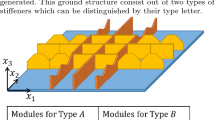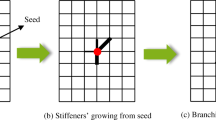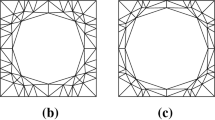Abstract
The application of the adaptive growth method is limited because several key techniques during the design process need manual intervention of designers. Key techniques of the method including the ground structure construction and seed selection are studied, so as to make it possible to improve the effectiveness and applicability of the adaptive growth method in stiffener layout design optimization of plates and shells. Three schemes of ground structures, which are comprised by different shell elements and beam elements, are proposed. It is found that the main stiffener layouts resulted from different ground structures are almost the same, but the ground structure comprised by 8-nodes shell elements and both 3-nodes and 2-nodes beam elements can result in clearest stiffener layout, and has good adaptability and low computational cost. An automatic seed selection approach is proposed, which is based on such selection rules that the seeds should be positioned on where the structural strain energy is great for the minimum compliance problem, and satisfy the dispersancy requirement. The adaptive growth method with the suggested key techniques is integrated into an ANSYS-based program, which provides a design tool for the stiffener layout design optimization of plates and shells. Typical design examples, including plate and shell structures to achieve minimum compliance and maximum bulking stability are illustrated. In addition, as a practical mechanical structural design example, the stiffener layout of an inlet structure for a large-scale electrostatic precipitator is also demonstrated. The design results show that the adaptive growth method integrated with the suggested key techniques can effectively and flexibly deal with stiffener layout design problem for plates and shells with complex geometrical shape and loading conditions to achieve various design objectives, thus it provides a new solution method for engineering structural topology design optimization.
Similar content being viewed by others
References
CHENG K T, OLHOFF N. An investigation concerning optimum design of solid elastic plates[J]. International Journal of Solids and Structures, 1981, 17: 305–323.
LAM Y C, SANTHIKUMAR S. Automated rib location and optimization for plate structures[J]. Structural Multidisciplinary Optimization, 2003, 25: 35–45.
ANSOLA R, CANALES J, TARRAGO J A, et al. Combined shape and reinforcement layout optimization of shell structures[J]. Structural Multidisciplinary Optimization, 2004, 27: 219–227.
AFONSO S M B, SIENZ J, BELBIDIA F. Structural optimization strategies for simple and integrally stiffened plates and shells[J]. Engineering Computation, 2005, 22(4): 429–452.
MAUTE K, ALLEN M. Conceptual design of aeroelastic structures by topology optimization[J]. Structural Multidisciplinary Optimization, 2004, 27: 27–42.
STANFORD B, BERAN P, BHATIA M. Aeroelastic topology optimization of blade-stiffened panels[C]//54th AIAA/ASME/ASCE/AHS/ASC Structures, Structural Dynamics, and Materials Conference, Boston, USA, April 8–11, 2013: AIAA 2 013-1 871.
PARK K S, YOUN S K. Topology optimization of shell structures using adaptive inner-front (AIF) level set method[J]. Structural Multidisciplinary Optimization, 2008, 36: 43–58.
BOJCZUK D, MROZ Z. Topological sensitivity derivative and finite topology modifications: application to optimization of plates in bending[J]. Structural Multidisciplinary Optimization, 2009, 39: 1–15.
PERCHIKOV N, FUCHS M B. Optimal layouts of stiffeners for plates in bending-topology optimization approach[C]// Proceedings of the 3rd European Conference on Computational Mechanics, Solids, Structures and Coupled Problems in Engineering, Lisbon, Portugal, 2006: 5–8.
PERCHIKOV N. Asymptotic bounds on the globally optimal positions of orthogonal stiffeners for rectangular plates in elastostatic bending[J]. Optimization and Engineering, 2011, DOI: 10.100 7/s11 081-011-9 161-3.
BADRAN S F, NASSEF A O, METWALLI S M. Y-stiffened panel multi-objective optimization using genetic algorithm[J]. Thin-walled Structures, 2009, 47(11): 1 331–1 342.
BOJCZUK D, SZTELEBLAK W. Optimization of layout and shape of stiffeners in 2D structures[J]. Computers and Structures, 2008, 86: 1 436–1 446.
DING X, YAMAZAKI K. Adaptive growth technique of stiffener layout pattern for plate and shell structures to achieve minimum compliance[J]. Engineering Optimization, 2005, 37(3): 259–276.
DING X, YAMAZAKI K. Stiffener layout design for plate structures by growing and branching tree model (application to vibration-proof design)[J]. Structural Multidisciplinary Optimization, 2004, 26(1-2): 99–110.
PARK M Y, PARK Y. Raising natural frequencies of a structure via surface-grooving technique[J]. Structural Multidisciplinary Optimization, 2007, 34: 491–505.
BARDT C, DZIEDZINIEWICZ M, KO J. Tools and Design Strategies to Study Rib Growth[J]. Computational Design Modelling (Part 1), 2012: 17–24.
MATTECK C. Design in nature: learning from trees[M]. Springer-Verlag Berlin Heidelberg, 1998.
NEUMANN F, SCHREINER W, NEUMANN M. Constrained constructive optimization of binary branching arterial tree models[C]//Proceeding of the 4th International Conference on Computer Aided Optimum Design of Structures (OPTI 95), Southampton, 1995: 181–188.
Ministry of Construction, PRC. GB50009-2001 Load code for the design of building structures[S]. Beijing: China Standards Press 2002. (in Chinese)
Author information
Authors and Affiliations
Corresponding author
Additional information
This project is supported by National Natural Science Foundation of China(Grants No. 50875174, 51175347), Innovation Program of Shanghai Municipal Education Commission(Grant No. 13ZZ114), and Capacity Building Project of Local University of Shanghai Municipal Science and Technology Commission(Grant No. 13160502500)
DING Xiaohong, born in 1965, is currently a professor at School of Mechanical Engineering, University of Shanghai for Science and Technology, China. She received her PhD degree from Kanazawa University, Japan, in 2004. Her research interests include structural design optimization, mechanical analysis of machinery structure.
JI Xuerong, born in 1985, is currently an engineer at Pan Asia Technical Automotive Center Co. Ltd. China. He received his master degree from University of Shanghai for Science and technology, China, in 2011. His research interest includes structural design optimization.
MA Man, born in 1986, is currently a master candidate at School of Mechanical Engineering, University of Shanghai for Science and technology, China. Her research interest includes structural design optimization.
Hou Jianyun, born in 1985, is currently a master candidate at School of Mechanical Engineering, University of Shanghai for Science and technology, China. Her research interest includes structural design optimization.
Rights and permissions
About this article
Cite this article
Ding, X., Ji, X., Ma, M. et al. Key techniques and applications of adaptive growth method for stiffener layout design of plates and shells. Chin. J. Mech. Eng. 26, 1138–1148 (2013). https://doi.org/10.3901/CJME.2013.06.1138
Received:
Revised:
Accepted:
Published:
Issue Date:
DOI: https://doi.org/10.3901/CJME.2013.06.1138




